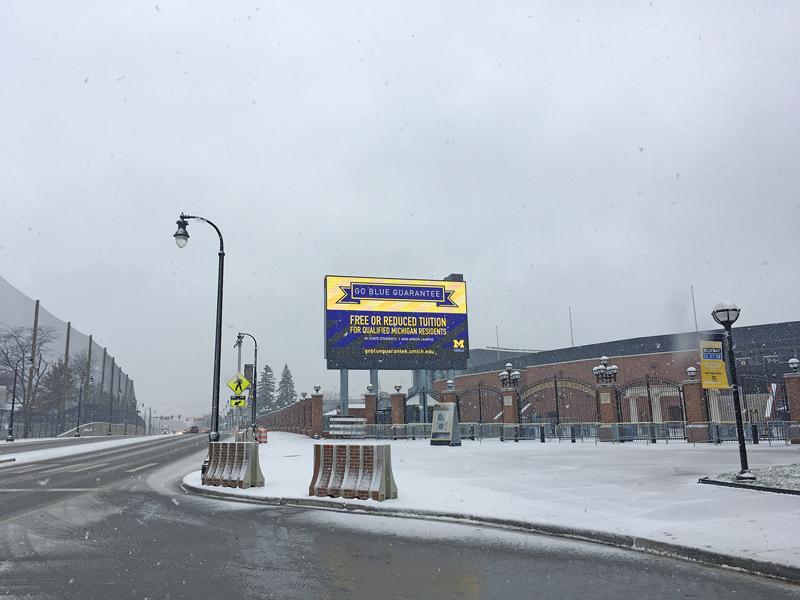The university has long argued that its reputation for being expensive is exaggerated. While out-of-state students face tuition bills approaching $50,000 a year, the list price for in-state undergrads under $15,000–and with financial aid, many pay less. BridgeMI.com recently compared tuition and other costs at Michigan’s public universities and concluded that for students whose families earn $75,000 or less a year, the “net cost of attendance” at the Ann Arbor campus is actually the lowest in the state.
Sharing that message is “what brought me to Michigan in the fall of 2014,” says Kedra Ishop, the U-M’s first vice provost for enrollment management. Internally, she had to bring together the offices of admissions, financial aid, the registrar, and new student programs. Externally, she was charged with figuring out “how do we better describe to our public the financial aid resources that we have available to students in the state of Michigan?
“What we know nationally is lower-income students tend not to see themselves able to apply to high-cost institutions because they don’t think they can afford it,” Ishop says, “even though they are academically qualified to be there.” So they looked for ways to get good students from low-income households to apply.
Provost Martha Pollack was very involved before she left to head Cornell last year. Former provost Paul Courant replaced her on an interim basis. By then, Courant says, administrators were putting the finishing touches on a plan to “send a very simple message” to less affluent Michigan residents: if they could get in, their tuition would be free.
They decided to target households earning no more than the state median. “Actually, our current [financial aid] policies weren’t very far away from that,” Courant recalls. “We basically said, ‘OK, let’s push on it and figure out, can it work? Do the numbers add up?’ And the answer turned out, with a little bit of effort, to be yes.”
In June 2017, President Schlissel announced the “Go Blue Guarantee”: students from households earning less than $65,000 a year and with assets of less than $50,000 can attend the Ann Arbor campus tuition-free.
It wasn’t really a huge change from what had already been available for years. But now it had a simple message, and a name. The university began advertising and promoting the guarantee widely in the UP, Detroit, and other lower-income areas–in high school visits, movie theater ads, and digitally.
It worked: an October release reported “a 24-percent increase in admissions applications from some of the state’s lowest-income students in the first year since implementing the guarantee, contributing to a nearly 6-percent increase in freshman enrollment from those with incomes of $65,000 or less.”
While those results are encouraging, they’re not transformative: the 26 percent of in-state undergrads paying no tuition is only one percentage point higher than last year. And while roughly 1,700 students are having their tuition covered by the Go Blue Guarantee this fall, that’s virtually unchanged from the number who were enrolled when it was applied retroactively to current students in January.
Ishop hopes this is just the start. “The commitment of the Go Blue Guarantee is meant to change the perception of affordability over time,” she emails, “which will hopefully lead to increases in applications from competitive low- and moderate-income families, leading to more offers of admissions, and greater enrollments.”
Though the Go Blue Guarantee is getting all the attention at the moment, it’s just part of the U-M’s financial aid toolkit. “Our lowest income students–students that have no expected family contribution–typically incomes of $25,000 or less–they are more likely to get a financial aid package that actually covers the full cost of attendance,” notes Ishop. “So they’re Go Blue Guarantee, but they’re going to be receiving Michigan Grant and other aid from us, too, which pays the full $28,000, and includes their room and board and other things.”
“People with much higher incomes will still get financial aid,” adds Courant. “There’s not a cliff at $65,000 at all. What happens if you’re at, let’s say, $70,000 is, you get almost as much aid–but you have to pay some tuition in the typical case.”
Ishop is excited about the prospects for building a more-inclusive student body. “What’s been so great for me personally is to be at a place that has the resources and the ambition and will do what it can in this space to try to be aggressive around socioeconomic and racial diversity,” she writes. The enrollment of students from underrepresented minorities, which nosedived after Michigan voters banned affirmative action in 2006, is already turning around.
According to the October release, “Of the 6,403 new freshmen who are U.S. citizens or permanent residents, 949 are underrepresented minorities that make up 14.8 percent of new freshmen, an increase from 13.9 percent last year and 10 percent in 2014.”
